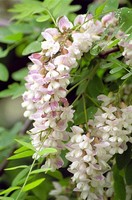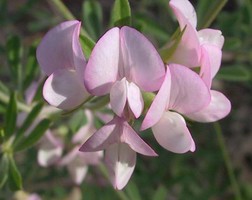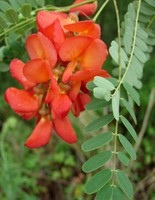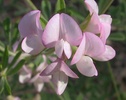Robinioid clade
Martin F. Wojciechowski and Bruce Jones


This tree diagram shows the relationships between several groups of organisms.
The root of the current tree connects the organisms featured in this tree to their containing group and the rest of the Tree of Life. The basal branching point in the tree represents the ancestor of the other groups in the tree. This ancestor diversified over time into several descendent subgroups, which are represented as internal nodes and terminal taxa to the right.

You can click on the root to travel down the Tree of Life all the way to the root of all Life, and you can click on the names of descendent subgroups to travel up the Tree of Life all the way to individual species.
For more information on ToL tree formatting, please see Interpreting the Tree or Classification. To learn more about phylogenetic trees, please visit our Phylogenetic Biology pages.
close boxIntroduction
Traditional tribes Loteae (including Coronilleae; sensu Polhill, 1994) and Robinieae (sensu Lavin and Sousa, 1995) comprise the "Robinioid clade". Loteae, consisting almost entirely of herbaceous annual/perennials or small shrubs distributed in the Mediterranean region and to a lesser extent in North and South America, has been traditionally considered closely related to other temperate, largely herbaceous Old World tribes, especially Galegeae as part of Dormer's (1945) 'epulvinate series' (Polhill, 1981). Robinieae, which is primarily a group of tropical and arid temperate trees and shrubs restricted to the New World (except for the pantropical Sesbania), has been considered related to Dalbergieae, Aeschynomeneae, and Millettieae.
The circumscription of Loteae was expanded by Polhill (1994) to include all genera formerly placed in tribe Coronilleae (Polhill 1981), which had been distinguished by the presence of lomented fruits and branched root nodules, features not observed in Loteae sens. strict. The merging of Loteae and Coronilleae is supported by both molecular and morphological data (e.g., Diez and Ferguson, 1990, 1994, 1996; Allan and Porter, 2000; Allan et al., 2003).
Sesbania is a pantropical genus of c. 60 species of herbs, shrubs, or trees (Lavin and Sousa, 1995) and of interest because of its unusual preference for seasonally wet, or flooded habitats, and the occurrence of "stem"-nodulation in some species (nodules are formed at adventitious root primordia on the lower stems) (Goormachtig et al., 2004). The treatment of Lavin and Schrire (2005b) now recognizes the separate tribe Sesbanieae, comprising one genus, Sesbania, and a more restricted tribe Robinieae with 11 genera and 72 species (Lavin and Schrire, 2005a).
Discussion of Phylogenetic Relationships
The robinioid clade includes tribes Loteae sens. lat. (incl. Coronilleae, sensu Polhill, 1994), Robinieae (Lavin and Schrire, 2005a), which are distributed primarily in the New World, northern Africa, and Europe, and the recently resurrected tribe Sesbanieae (Lavin and Schrire, 2005b). Within this clade, the pantropical Sesbania L. (Sesbanieae) is monophyletic and weakly resolved as the sister group to Loteae sens. lat., a finding first suggested by a preliminary analysis of matK gene sequences (Wojciechowski et al., 2000) and later supported by an exhaustive sampling of additional matK sequences (Lavin et al., 2003; Wojciechowski et al., 2004). Evidence (nuclear rDNA ITS sequences) for Sesbania as the sister group to the remaining Robinieae, rather than to Loteae sens. lat., has also been reported by Lavin et al. (2003). Based on these molecular phylogenetic studies of robinioids (Lavin et al., 2003; Wojciechowski et al., 2004), Sesbania is either sister to remaining members of Robinieae, or to Loteae sens. lat. and together they form a weak-supported sister group to the remaining Robinieae. Resolution of this uncertainty in relationships among the major lineages of the robinioid legumes is a subject of active investigation.
The most recent phylogeny of Loteae sens. lat. provides molecular evidence for its monophyly but suggests the large genus Lotus, which includes the genetic/genomic model Lotus corniculatus L. subsp. japonicus (Regel) H. Ohashi, is paraphyletic (Allan et al., 2003). In that analysis, Old World Lotus is a moderately supported monophyletic group (if the genera Tetragonolobus and Dorycnium are included), while New World Lotus is paraphyletic. Relationships within a recircumscribed Robinieae, which includes genera such as Robinia L. (black locust), Olneya A. Gray (ironwood), and Coursetia DC., have been resolved by recent, comprehensive molecular phylogenetic analyses (Lavin et al., 2003).
References
Allan, G. J., and J. M. Porter. 2000. Tribal delimitation and phylogenetic relationships of Loteae and Coronilleae (Faboideae: Fabaceae) with special reference to Lotus: evidence from nuclear ribosomal ITS sequences. American J. Botany 87: 1871-1881.
Allan, G. J., E. A. Zimmer, W. L. Wagner, and D. D. Sokoloff. 2003. Molecular phylogenetic analyses of tribe Loteae (Leguminosae): implications for classification and biogeography. Pages 371-393 in Advances in legume systematics, part 10, higher level systematics (B.B. Klitgaard and A. Bruneau, eds.). Royal Botanic Gardens, Kew, UK.
Diez, M. J., and I. K. Ferguson. 1990-1996. Studies of the pollen morphology and taxonomy of the tribes Loteae and Coronilleae (Leguminosae: Papilionoideae). Part 1. (1990) Lagascalia 16: 77-94; Part 2. (1994). Review of Palaeobotany and Palynology 81: 233-255; Part 3. (1996). Review of Palaeobotany and Palynology 94: 239-257.
Goormachtig, S., W. Capoen, and M. Holsters. 2004. Rhizobium infection: lessons from the versatile nodulation behaviour of water-tolerant legumes. Trends in Plant Science 9: 518-522.
Lavin, M., and B. D. Schrire. 2005a. Robinieae. Pages 467-473 in Legumes of the world (Lewis et al., eds.). Royal Botanic Gardens, Kew, UK.
Lavin, M., and B. D. Schrire. 2005b. Sesbanieae. Pages 452-453 in Legumes of the world (Lewis et al., eds.). Royal Botanic Gardens, Kew, UK.
Lavin, M., and M. Sousa. 1995. Phylogenetic systematics and biogeography of the tribe Robineae (Leguminosae). Systematic Botany Monographs 45: 1-165.
Lavin, M., M. F. Wojciechowski, P. Gasson, C. E. Hughes, and E. Wheeler. 2003. Phylogeny of robinioid legumes (Fabaceae) revisited: Coursetia and Gliricidia recircumscribed, and a biogeographical appraisal of the Caribbean endemics. Systematic Botany 28: 387–409.
Polhill, R. M. 1981. Papilionoideae. Pages 191-208 in Advances in legume systematics, part 1 (R. M. Polhill and P. H. Raven, eds.). Royal Botanic Gardens, Kew, UK.
Polhill, R. M. 1994. Classification of the Leguminosae. Pages xxxv-xlviii in Phytochemical Dictionary of the Leguminosae (F.A. Bisby, J. Buckingham, and J.B. Harborne, eds.). Chapman and Hall, New York, NY.
Wojciechowski, M. F., M. Lavin, and M. J. Sanderson. 2004. A phylogeny of legumes (Leguminosae) based on analysis of the plastid matK gene resolves many well-supported subclades within the family. American J. Botany 91: 1846-1862.
Wojciechowski, M. F., M. J. Sanderson, K. P. Steele, and A. Liston. 2000. Molecular phylogeny of the “temperate herbaceous tribes” of papilionoid legumes: a supertree approach. Pages 277-298 in Advances in Legume Systematics, part 9 (P. S. Herendeen and A. Bruneau, eds.). Royal Botanic Gardens, Kew, UK.
Title Illustrations

| Scientific Name | Robinia pseudoacacia L. |
|---|---|
| Specimen Condition | Live Specimen |
| Copyright |
© 2006
Nick Kurzenko

|
| Scientific Name | Lotus australis Andrews |
|---|---|
| Location | Land's End restoration area, Australia |
| Specimen Condition | Live Specimen |
| Copyright | © 2006 Jeff Reid |
| Scientific Name | Sesbania punicea Benth. |
|---|---|
| Location | Florida, USA |
| Specimen Condition | Live Specimen |
| Copyright | © 2006 Frank Farrugia |
About This Page
Martin F. Wojciechowski

Arizona State University, Tempe, Arizona, USA
Bruce Jones

Arizona State University
Correspondence regarding this page should be directed to Martin F. Wojciechowski at
mfwojciechowski@asu.edu
and Bruce Jones at
Rodney.B.Jones@asu.edu
Page copyright © 2006 Martin F. Wojciechowski and Bruce Jones
All Rights Reserved.
- First online 14 June 2006
- Content changed 14 June 2006
Citing this page:
Wojciechowski, Martin F. and Bruce Jones. 2006. Robinioid clade. Version 14 June 2006 (under construction). http://tolweb.org/Robinioid_clade/60365/2006.06.14 in The Tree of Life Web Project, http://tolweb.org/











 Go to quick links
Go to quick search
Go to navigation for this section of the ToL site
Go to detailed links for the ToL site
Go to quick links
Go to quick search
Go to navigation for this section of the ToL site
Go to detailed links for the ToL site